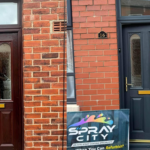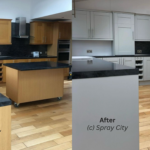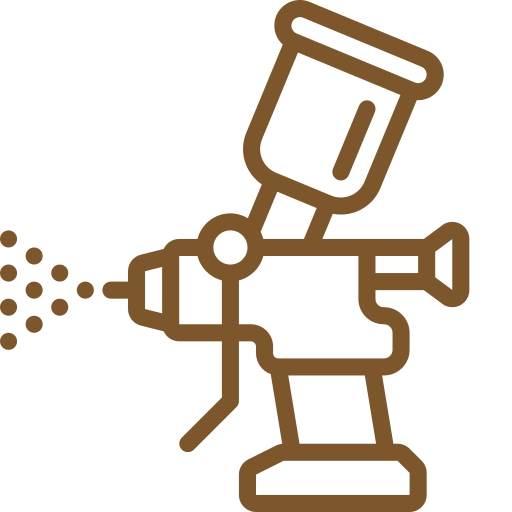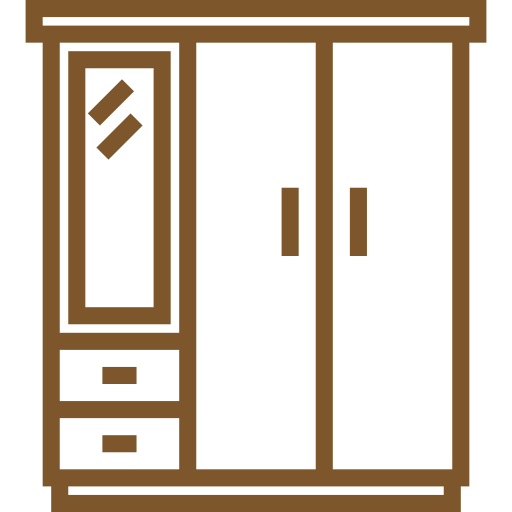Introduction
The first impression your business makes is almost as important as your customer service. A visually appealing and well-maintained building is crucial for attracting and retaining customers. Faded paint, chipped surfaces, and a worn exterior project a negative image of neglect and disrepair. For commercial properties especially, the exterior outlook and overall condition significantly impact your brand’s perception and customer experience. That’s where commercial spraying comes in. Commercial spraying can easily transform your property, giving it a new and modern aesthetic that reflects your business’s commitment to quality and professionalism.
This article looks into the numerous benefits of commercial spraying, its various applications and the complete step by step guide in case you want to go the DIY route.
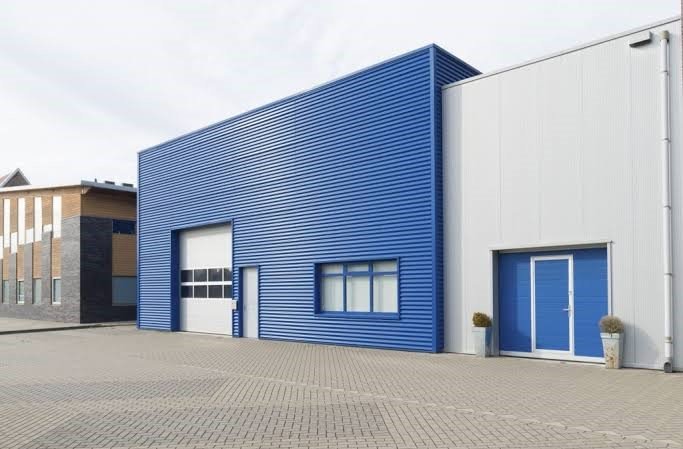
What is Commercial Spraying?
Commercial spraying is the process of applying paint to large surfaces in commercial settings using specialized spray equipment. It’s different from regular spray painting in a few ways:
- Scale: Commercial spray painting deals with bigger areas like warehouses, buildings, factories, or large equipment.
- Equipment: It utilizes heavy-duty, high-volume spray guns for faster application and more consistent finishes compared to basic aerosol cans.
- Focus: While aesthetics are important, commercial spray painting often emphasizes more on functionality. Paints used can be chosen for specific properties like durability, resistance to corrosion or chemicals, or fire protection.
- Expertise: Commercial spray painting projects are often complex and require trained professionals who understand proper application techniques, safety protocols, and regulations related to paint materials in commercial environments.
Advantages of Commercial Spraying
A fresh coat of paint isn’t just aesthetically pleasing for commercial properties; it can significantly impact functionality, safety, and even energy efficiency. Here are some key benefits of commercial spraying:
1. Efficiency and Speed:
Spraying is a much faster application process and delivers a smooth, even coat in a fraction of the time compared to using rollers or brushes. This minimises disruption to your business operations and allows for quicker project completion which is especially beneficial for businesses that operate during regular business hours.
2. Superior Finish:
Spray application provides a more consistent and smooth finish compared to brush or roller marks. This is particularly crucial for achieving a clean, polished look for high-visibility areas like business premises and ensures a more professional look for your commercial property.
3. Reduced Cost:
While the initial cost of equipment may be higher, commercial spraying can often be more cost-effective in the long run due to its efficiency and reduced labour costs. Additionally, the use of high-quality coatings reduces the need for frequent repainting in the long run.
4. Improved Coverage:
Spray painting ensures complete and even coverage, even in hard-to-reach areas or intricate designs, minimizing the risk of missed spots and potential future problems.
5. Durability:
Commercial spray paints are formulated for superior performance and weather resistance. They provide a tougher and more resilient finish compared to traditional paint, protecting your property from the elements. This translates to a longer lifespan for your paintwork and reduced maintenance needs.
6. Versatility:
Commercial spraying can be used on a wide range of surfaces, including walls, ceilings, floors, metal cladding, and even furniture. This versatility makes it ideal for both interior and exterior applications and various other applications within your commercial property.

Applications of Commercial Spraying
The versatility of commercial spraying makes it suitable for a wide range of projects in different commercial settings. Here are some of the most common applications:
1. Warehouse and Industrial Painting:
Spacious warehouses and industrial settings require durable, easy-to-maintain finishes. Commercial spraying ensures a uniform, long-lasting coat that can withstand heavy traffic and harsh environments. Additionally, specific coatings can be applied to enhance safety features and improve visibility within the workspace.
2. Retail Spraying:
Retail stores benefit significantly from a vibrant and visually appealing exterior. Commercial spraying allows for the application of bold colours, logos, and unique finishes that instantly grab attention and create a lasting impression on potential customers.
3. Office Painting:
A professional and well-maintained office environment fosters a positive and productive atmosphere for employees and clients alike. Commercial spraying offers a clean and efficient way to update office interiors, creating a modern and stylish workspace.
4. Cladding Spraying:
Metal cladding is a popular choice for commercial buildings due to its durability and weather resistance. However, over time, cladding can become faded or scratched. Commercial spraying provides a cost-effective solution for restoring the original appearance of cladding and extending its lifespan.
5. Fireproofing Spraying:
Commercial spraying extends beyond aesthetics. Specialised coatings can be applied to meet specific safety and functional requirements. Fireproofing coatings are crucial for enhancing the fire resistance of building materials, ensuring occupant safety in case of fire. Additionally, anti-slip coatings can be applied to floors in high-traffic areas to prevent slips and falls.
6. Anti-Corrosive Coatings:
Spray-applied anti-corrosive coatings provide superior protection for metal structures, extending their lifespan and reducing maintenance costs.
7. Food-Safe Coatings:
Certain spray paints are formulated for use in areas where food is processed or handled, ensuring compliance with hygiene regulations.
8. Signage and Murals:
Eye-catching signage and large-scale murals can be efficiently created using spray painting techniques.

Equipment Needed For Commercial Spraying
Here’s a breakdown of the equipment needed for commercial spray painting:
- Airless Sprayer: This is the workhorse for commercial jobs, available in electric or gas-powered models. It uses high pressure to atomize paint without compressed air, ideal for high-volume applications. Choose the appropriate size based on project scale and paint viscosity.
- Spray Gun: Select a spray gun with a tip size suitable for the type of paint you’re using. Different tip sizes offer variations in spray pattern and material flow.
- Hoses and Filters: High-pressure hoses carry paint from the sprayer to the gun and in-line filters ensure smooth paint flow by removing impurities.
- Pressure Regulator: Controls the air pressure delivered to the gun, crucial for proper paint atomization.
- Paint Container(optional): Buckets, mixing sticks, and power mixers for large quantities of paint.
- Safety and Protection Gear:
- Respirator
- Safety Glasses
- Gloves
- Coveralls
- Drop Cloths and Sheeting: Protect floors, furniture and surrounding areas from paint splatter.
- Masking Tape and Paper: For creating clean lines and masking off areas you don’t want painted.
- Sandpaper and Degreaser: For surface preparation tasks like sanding and degreasing.
- Cleaning Brushes and Solvents: For cleaning your spray gun and equipment after use.
- Power Washer(optional): This can be helpful for heavy-duty cleaning tasks during surface preparation.
- Scaffolding or Ladders(optional): For reaching high areas safely.
- Heater/Air Mover: Can help accelerate drying time in controlled environments.
- Paint Heater/Stirrer(optional): If using thick paints, a heater and stirrer can help maintain proper viscosity for spraying.
Remember, the specific equipment needs may vary depending on the size and complexity of your project, as well as the type of paint you’re using. Always consult the paint manufacturer’s recommendations and prioritize safety by using the appropriate PPE.
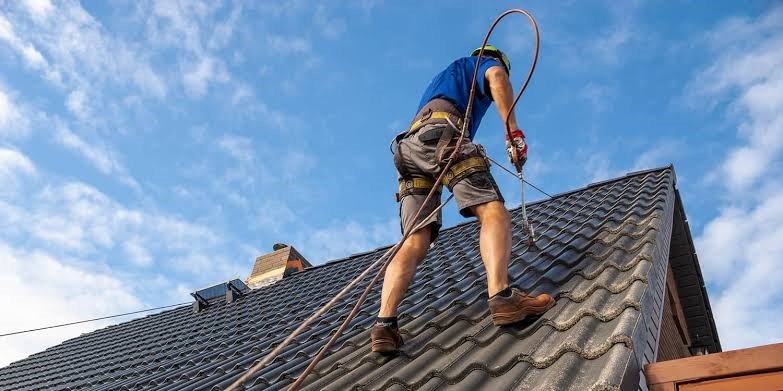
A Step-by-Step Guide On Commercial Spraying
Here’s a breakdown of the spray painting process:
PREPARATION
- Project Assessment:
– Identify the surface to be sprayed (walls, ceilings, etc.) and measure the area.
– Determine the type of coating material needed based on desired outcome (fireproofing, soundproofing, aesthetics).
– Check for any existing damage that needs repair before spraying.
- Surface Prep:
– Ensure the surface is clean, free of dust, dirt, grease, or loose paint.
– Patch any holes or cracks to create a smooth surface for optimal coating adhesion.
– Cover any areas that shouldn’t be sprayed (windows, trim) with masking materials.
– Ventilation: Proper ventilation is crucial, as spraying materials often emit fumes. Open windows and doors, and use exhaust fans if available.
- Equipment Setup:
– Prepare the spraying equipment according to the manufacturer’s instructions. This typically involves mixing the coating material and setting up the spray gun with the appropriate nozzle size and air pressure.
– Prepare the paint according to the manufacturer’s instructions. This might involve thinning or mixing components.
SPRAY APPLICATION:
- Initial Spray:
– Wear proper personal protective equipment (PPE) like gloves, respirator, and safety glasses.
– Start with a thin test coat on a small, inconspicuous area to check for compatibility and desired finish.
– Adjust spraying technique and equipment settings if needed.
- Full Coverage:
– Apply the coating in smooth, even strokes, using a controlled sweeping motion.
– Maintain a consistent distance between the spray nozzle and the surface.
– Overlap each pass slightly to ensure complete coverage and avoid streaking.
– Pay close attention to corners, edges, and uneven surfaces for thorough application.
– Allow each coat to dry completely before applying the next.
- Coating Layers:
– Depending on the project requirements, multiple coats may be necessary to achieve the desired thickness and finish.
– Allow for adequate drying time between coats as specified by the coating material.
COMPLETION:
- Drying and Curing:
– Allow sufficient drying time for the final coat as recommended by the manufacturer.
– Remove protective coverings and ventilate the area until fumes dissipate.
- Cleanup:
– Carefully remove masking materials while the paint is still slightly wet to prevent tearing. Clean your spray gun thoroughly following the manufacturer’s instructions.
– Once dry, inspect the painted surface for any imperfections, missed spots, or overspray. Touch up minor areas if necessary.
How Much Does Commercial Spraying Cost?
Budgeting for commercial spray painting can vary significantly depending on several factors. Here’s a breakdown to help you estimate costs:
- Size of the Area: The larger the surface area requiring painting, the higher the overall cost.
- Number of Coats: More coats are often needed for better coverage and desired finish, impacting the labor and paint material cost.
- Surface Condition: Heavily damaged or unprepared surfaces might require additional work like power washing or scraping, leading to increased costs.
- Type of Paint: Specialty paints with higher durability, fire resistance, or specific finishes can be more expensive than standard paints.
- Project Complexity: Complex projects involving intricate details, multiple colors, or hard-to-reach areas will likely require more time and expertise, affecting the budget.
- Labor Rates: Painting contractor fees can vary depending on location, experience, and the size of the crew needed.
Cost Estimates (Ballpark Figures):
Per Square Meter: In the UK, commercial painting costs typically range from £3 to £10 per square meter per coat.
Project Cost: Simple office repainting might cost £150 to £1150, whereas painting an industrial unit’s cladding could range from £3,000 to £10,000.
Tips for Budgeting
–Get multiple detailed quotes outlining labor costs, materials, and the number of coats included.
–Be upfront about the project details and any specific requirements you have. This helps contractors provide a more accurate estimate.
–Factor in prep work like surface cleaning, masking, or minor repairs as they can add to the cost.
Conclusion
While commercial spray painting offers a tempting solution for DIY enthusiasts, it’s important to remember the complexities involved. The specialized equipment, safety protocols, and knowledge of paint properties are important for achieving a professional and safe outcome. For guaranteed quality and adherence to regulations, consider hiring a reputable commercial spray painting company like Spray City that can ensure a smooth, efficient, and lasting transformation for your space.
The Spray City Difference
At Spray City, we are your trusted professionals for flawless paint finishes. We offer high-quality spray paints, expert advice, and a team of experienced spray painters to deliver exceptional results.
Contact us today for a free quote and let us help you transform your home into a mural that showcases your personal style and creativity!


